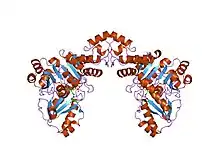| Cys_Met_Meta_PP | |||||||||
|---|---|---|---|---|---|---|---|---|---|
 cystathionine beta-lyase (cbl) from escherichia coli in complex with n-hydrazinocarbonylmethyl-2-trifluoromethyl-benzamide | |||||||||
| Identifiers | |||||||||
| Symbol | Cys_Met_Meta_PP | ||||||||
| Pfam | PF01053 | ||||||||
| Pfam clan | CL0061 | ||||||||
| InterPro | IPR000277 | ||||||||
| PROSITE | PDOC00677 | ||||||||
| SCOP2 | 1cs1 / SCOPe / SUPFAM | ||||||||
| CDD | cd00614 | ||||||||
| |||||||||
In molecular biology, the Cys/Met metabolism PLP-dependent enzyme family is a family of proteins including enzymes involved in cysteine and methionine metabolism which use PLP (pyridoxal-5'-phosphate) as a cofactor.[1]
Mechanism of action
PLP is employed as it binds to amino groups and stabilises carbanion intermediates. PLP enzymes exist in their resting state as a Schiff base, the aldehyde group of PLP forming a linkage with the epsilon-amino group of an active site lysine residue on the enzyme. The alpha-amino group of the substrate displaces the lysine epsilon-amino group, in the process forming a new aldimine with the substrate. This aldimine is the common central intermediate for all PLP-catalysed reactions, enzymatic and non-enzymatic.[2]
Function
PLP is the active form of vitamin B6 (pyridoxine or pyridoxal). PLP is a versatile catalyst, acting as a coenzyme in a multitude of reactions, including decarboxylation, deamination and transamination.[3][4][5]
A number of pyridoxal-dependent enzymes involved in the metabolism of cysteine, homocysteine and methionine have been shown to be evolutionary related.[1] These enzymes are tetrameric proteins of about 400 amino-acid residues. Each monomer has an active site, which however requires the N-terminal of another monomer to be completed (salt bridges to phosphate and entrance way). The phosphopyridoxyl group is attached to a lysine residue located in the central section of these enzymes and is stabilised by π-stacking interactions with a tyrosine residue above it.[6]
Family members
There are five different structurally related types of PLP enzymes. Members of this family belong to the type I and are:[1]
- in the transsulfurylation route for methionine biosynthesis:
- Cystathionine γ-synthase (metB) which joins an activated homoserine ester (acetyl or succinyl) with cysteine to form cystathionine
- Cystathionine β-lyase (metC) which splits cystathionine into homocysteine and a deaminated alanine (pyruvate and ammonia)
- in the direct sulfurylation pathway for methionine biosynthesis:
- O-acetyl homoserine sulfhydrylase (metY) which adds a thiol group to an activated homoserine ester
- O-succinylhomoserine sulfhydrylase (metZ) which adds a thiol group to an activated homoserine ester
- in the reverse transsulfurylation pathway for cysteine biosynthesis:
- Cystathionine γ-lyase (no common gene name) which joins an activated serine ester (acetyl or succinyl) with homocysteine to form cystathionine
- Not Cystathionine β-synthase which is a PLP enzyme type II
- cysteine biosynthesis from serine:
- O-acetyl serine sulfhydrylase (cysK or cysM) which adds a thiol group to an activated serine ester
- methionine degradation:
- Methionine gamma-lyase (mdeA) which breaks down methionine at the thioether and amine bounds
Note: MetC, metB, metZ are closely related and have fuzzy boundaries so fall under the same NCBI orthologue cluster (COG0626).[1]
References
- 1 2 3 4 Ferla MP, Patrick WM (2014). "Bacterial methionine biosynthesis". Microbiology. 160 (Pt 8): 1571–84. doi:10.1099/mic.0.077826-0. PMID 24939187.
- ↑ Toney MD (January 2005). "Reaction specificity in pyridoxal phosphate enzymes". Arch. Biochem. Biophys. 433 (1): 279–87. doi:10.1016/j.abb.2004.09.037. PMID 15581583.
- ↑ Hayashi H (September 1995). "Pyridoxal enzymes: mechanistic diversity and uniformity". J. Biochem. 118 (3): 463–73. doi:10.1093/oxfordjournals.jbchem.a124931. PMID 8690703.
- ↑ John RA (April 1995). "Pyridoxal phosphate-dependent enzymes". Biochim. Biophys. Acta. 1248 (2): 81–96. doi:10.1016/0167-4838(95)00025-p. PMID 7748903.
- ↑ Eliot AC, Kirsch JF (2004). "Pyridoxal phosphate enzymes: mechanistic, structural, and evolutionary considerations". Annu. Rev. Biochem. 73: 383–415. doi:10.1146/annurev.biochem.73.011303.074021. PMID 15189147.
- ↑ Aitken SM, Lodha PH, Morneau DJ (2011). "The enzymes of the transsulfuration pathways: Active-site characterizations". Biochimica et Biophysica Acta (BBA) - Proteins and Proteomics. 1814 (11): 1511–7. doi:10.1016/j.bbapap.2011.03.006. PMID 21435402.